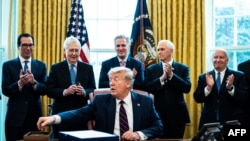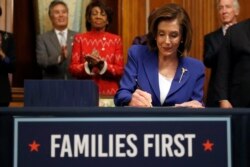Within hours of the U.S. House's overwhelming approval of a $2 trillion bill to blunt the economic destruction caused by the coronavirus, President Donald Trump signed the legislation into law.
The rare and speedy bipartisan consensus in Congress to back the bill, the largest emergency aid package in American history, underscored the price of the pandemic.
"I want to thank Democrats and Republicans for coming together and putting America first,” Trump said as he signed the bill, adding, “I’ve never signed anything with a T [for trillion].”
The bipartisanship did not extend to the Oval Office, with only Republican lawmakers present, including Senate Majority Leader Mitch McConnell.
“It's a proud moment for all of us,” McConnell said, praising the speed with which his fellow lawmakers worked for passage in record time.
The president was also surrounded in the 75-square-meter room in the era of social distancing by Vice President Mike Pence, four members of his Cabinet and several other officials.
Checks, loans
Checks will be sent directly to individuals and families, unemployment benefits are to be greatly expanded, overwhelmed hospitals and health care providers will get government funding, and hundreds of billions of dollars in aid and loans will go to small businesses and big corporations.
With the legislation enacted, the focus returns to what is happening on the front lines of the battle against the disease, which has infected more people in the United States than in any other country, according to statistics compiled by epidemiologists tracking the global spread of the virus.
More than 100,000 people in the United States are known to have been infected by the virus and nearly 1,500 have died, including at least 366 in New York City alone.
Health care workers in New York City, New Orleans and Detroit, among others, have spoken of watching patients go within hours from seemingly not seriously ill to gasping for air and needing assistance to breathe.
More ventilators
Trump on Friday demanded increased production of ventilators, a day after he questioned whether so many were required during the pandemic.
"I don't believe you need 40,000 or 30,000 ventilators," Trump said on Fox News. "You know, you're going to major hospitals sometimes, they'll have two ventilators. And now, all of a sudden, they're saying, can we order 30,000 ventilators?”
In tweets on Friday morning, however, the president blamed automaker General Motors from backing off a promise to produce 40,000 ventilators very quickly and attacked the corporation’s chief executive officer, Mary Barra, accusing her of wanting “top dollar” for such work.
Later in the day, GM said in a statement with Ventec that the two companies would deliver their first ventilators by next month and would eventually ramp up to a manufacturing capacity of more than 10,000 per month.
That wasn’t good enough for the president.
In a statement, Trump said he had invoked a wartime law and directed the secretary of health and human services “to use any and all authority available under the Defense Production Act to require General Motors to accept, perform and prioritize federal contracts for ventilators. Our negotiations with GM regarding its ability to supply ventilators have been productive, but our fight against the virus is too urgent to allow the give-and-take of the contracting process to continue to run its normal course.”
The president accused GM of “wasting time,” saying his order “will help ensure the quick production of ventilators that will save American lives.”
Another American automaker, Ford, says it is in “active conversations with the administration, seeking guidance about approvals, scope and distribution relating to a series of products, including ventilators.”
Trump also signed an order Friday activating the military. The president said this would allow for the mobilization of uniformed medical personnel to help fight COVID-19.
“No effort will be spared in winning this war,” he said.
Pence told reporters that an airlift was being organized to bring from other countries to the United States protective equipment for medical workers. He also said administrators facing shortages of needed equipment should alert the emergency managers of their state.
Wall Street remained worried. The Dow Jones industrial average on Friday closed down 915 points, a drop of 4 percent, snapping a winning streak that for the week saw the key index gaining 13 percent for its best week since 1938.
Stock prices overall, however, remain far below the levels of late February, when concerns about the spread of the novel coronavirus began to create widespread anxiety among traders.































